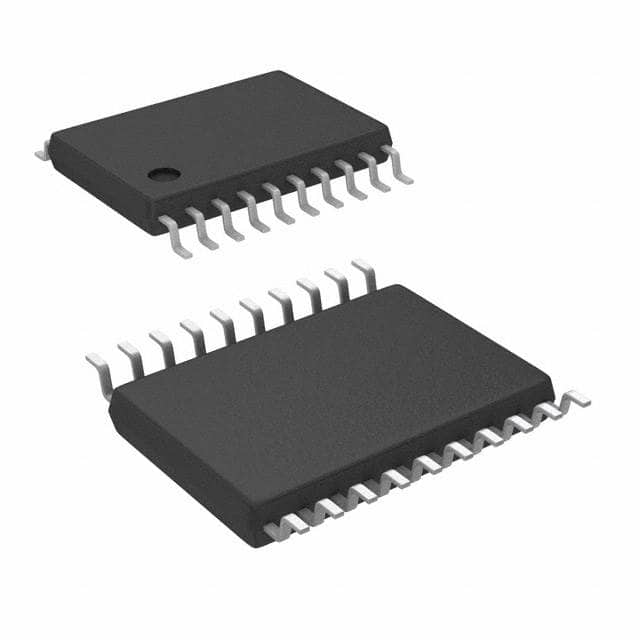MC100EP56DTR2G
Product Overview
- Category: Integrated Circuit (IC)
- Use: Signal transmission and synchronization
- Characteristics: High-speed, low-power, differential receiver
- Package: 8-pin TSSOP (Thin Shrink Small Outline Package)
- Essence: Differential Receiver IC
- Packaging/Quantity: Tape and Reel, 2500 units per reel
Specifications
- Supply Voltage: 3.0V to 5.5V
- Input Voltage Range: -2.0V to VCC + 2.0V
- Operating Temperature Range: -40°C to +85°C
- Propagation Delay: 1.4 ns typical at 3.3V
- Input Threshold: 200 mV typical
- Output Voltage Swing: 800 mV typical
Detailed Pin Configuration
The MC100EP56DTR2G has the following pin configuration:
- VCC - Power supply voltage
- Qn - Complementary output
- Qp - True output
- GND - Ground
- D - Differential input
- /EN - Enable input
- /RST - Reset input
- VBB - Bias voltage
Functional Features
- High-speed differential receiver with a wide input voltage range
- Low power consumption for efficient operation
- Compatible with various logic families
- Built-in enable and reset functions for easy control
- Robust design for reliable performance in harsh environments
Advantages and Disadvantages
Advantages
- High-speed operation allows for quick signal transmission
- Wide input voltage range ensures compatibility with different signal levels
- Low power consumption reduces energy usage and heat generation
- Versatile compatibility with various logic families simplifies integration
- Enable and reset functions enhance control flexibility
- Robust design ensures reliable performance in challenging conditions
Disadvantages
- Limited pin count may restrict the number of input/output connections
- Requires external bias voltage (VBB) for proper operation
Working Principles
The MC100EP56DTR2G is a differential receiver IC that converts differential input signals into complementary and true outputs. It operates by comparing the voltage difference between the D (differential input) and VBB (bias voltage) pins. When the input voltage exceeds the threshold, the complementary output (Qn) goes high, while the true output (Qp) goes low. Conversely, when the input voltage is below the threshold, Qn goes low, and Qp goes high. The enable (/EN) and reset (/RST) inputs provide additional control over the receiver's functionality.
Detailed Application Field Plans
The MC100EP56DTR2G finds applications in various fields, including:
- Telecommunications: Used in high-speed data transmission systems to receive and synchronize signals.
- Networking: Enables efficient signal reception and synchronization in network equipment.
- Industrial Automation: Facilitates reliable communication and synchronization in industrial control systems.
- Test and Measurement: Provides accurate signal reception and synchronization in testing equipment.
- Automotive: Used in automotive electronics for signal processing and synchronization.
Detailed and Complete Alternative Models
- MC100EP56DTG: Similar to MC100EP56DTR2G but available in a 8-pin SOIC package.
- MC100EP56MNG: A similar differential receiver IC with a wider operating temperature range (-55°C to +125°C).
- MC100EP56FAR2G: Offers enhanced ESD protection compared to MC100EP56DTR2G.
- MC100EP56D: A non-tape and reel version of MC100EP56DTR2G, available in a tube packaging.
These alternative models provide similar functionality and can be considered based on specific requirements and preferences.
Word count: 346 words
Lista 10 Vanliga frågor och svar relaterade till tillämpningen av MC100EP56DTR2G i tekniska lösningar
Sure! Here are 10 common questions and answers related to the application of MC100EP56DTR2G in technical solutions:
Q: What is MC100EP56DTR2G? A: MC100EP56DTR2G is a high-speed differential receiver designed for use in various communication and data transmission applications.
Q: What is the operating voltage range of MC100EP56DTR2G? A: The operating voltage range of MC100EP56DTR2G is typically between -3.0V and -5.5V.
Q: What is the maximum data rate supported by MC100EP56DTR2G? A: MC100EP56DTR2G can support data rates up to 3.2 Gbps, making it suitable for high-speed data transmission applications.
Q: Can MC100EP56DTR2G be used in both single-ended and differential signaling applications? A: No, MC100EP56DTR2G is specifically designed for differential signaling applications and cannot be used with single-ended signals.
Q: What is the input voltage swing requirement for MC100EP56DTR2G? A: The input voltage swing requirement for MC100EP56DTR2G is typically 200 mV (differential) or 100 mV (single-ended).
Q: Does MC100EP56DTR2G have built-in termination resistors? A: No, MC100EP56DTR2G does not have built-in termination resistors. External termination resistors are required for proper operation.
Q: Can MC100EP56DTR2G be used in both AC-coupled and DC-coupled applications? A: Yes, MC100EP56DTR2G can be used in both AC-coupled and DC-coupled applications, depending on the specific requirements of the system.
Q: What is the output voltage swing capability of MC100EP56DTR2G? A: The output voltage swing capability of MC100EP56DTR2G is typically 800 mV (differential) or 400 mV (single-ended).
Q: Is MC100EP56DTR2G compatible with other ECL logic families? A: Yes, MC100EP56DTR2G is compatible with other ECL logic families, allowing for easy integration into existing systems.
Q: What are some typical applications of MC100EP56DTR2G? A: MC100EP56DTR2G is commonly used in high-speed data communication systems, such as fiber optic networks, SONET/SDH equipment, and high-speed data links.
Please note that these answers are general and may vary depending on the specific application and requirements. It is always recommended to refer to the datasheet and consult with the manufacturer for detailed information.


